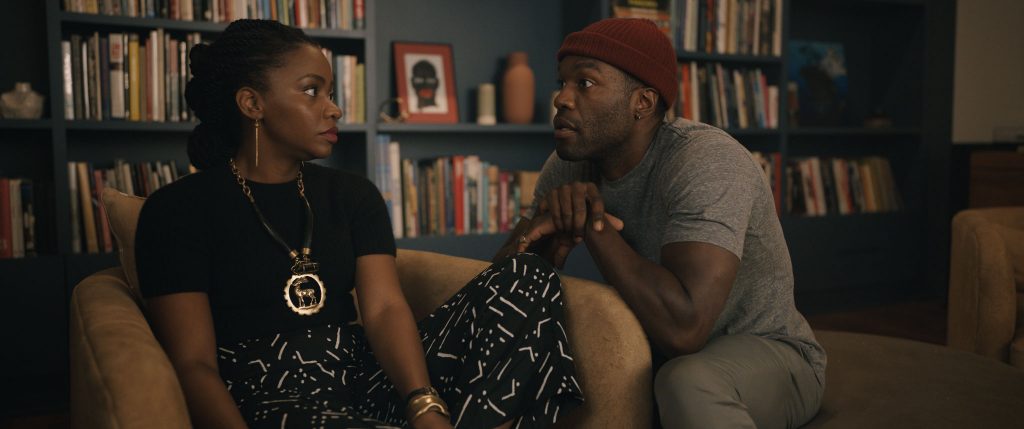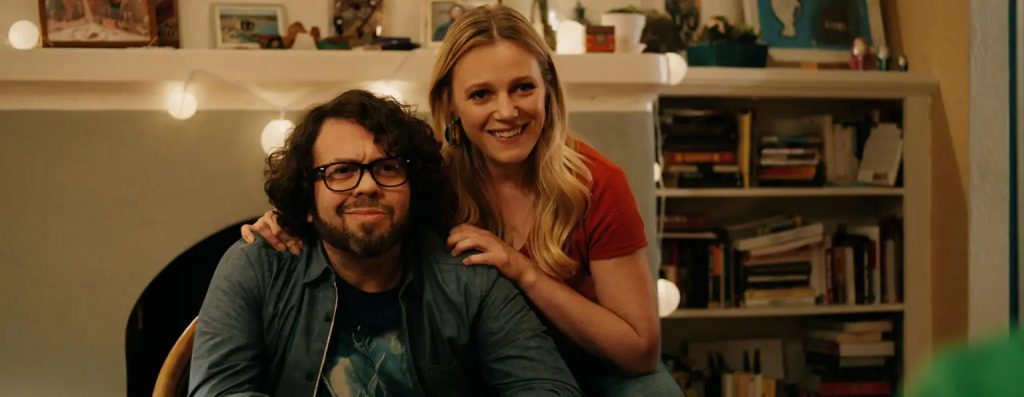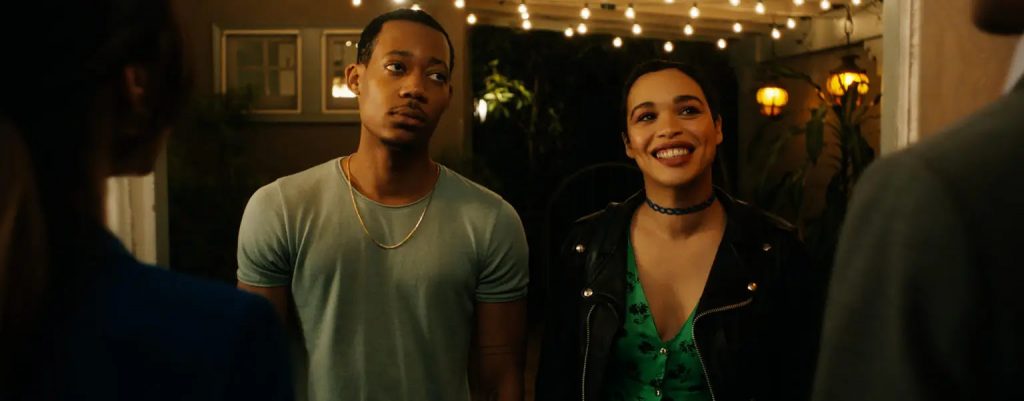August 25, 2021
by Carla Hay

Directed by Nia DaCosta
Culture Representation: Taking place in Chicago, the horror film “Candyman” features a predominantly African American cast of characters (with some white people and a few Asians) representing the middle-class and working-class.
Culture Clash: An up-and-coming conceptual artist (whose latest art exhibition explores themes of racism against black people) experiences the horror of Candyman, a legendary African American ghost representing black people who have been the targets of violent racism.
Culture Audience: “Candyman” will appeal primarily to people who are fans of the 1992 “Candyman” movie, filmmaker Jordan Peele and horror movies that have themes of racial inequalities and social justice.

The 2021 movie “Candyman” is not a remake/reboot of the 1992 horror movie “Candyman” It’s a very worthy sequel that takes a more creative and more socially conscious approach to race relations and racist violence than the first “Candyman” movie. The 2021 “Candyman” somewhat sputters out toward the end, almost like the filmmakers ran out of ideas of how the story should conclude. But most of the movie strikes the right balance of paying homage to the original “Candyman” while coming up with its own clever sequel story.
The fact that the 2021 “Candyman” movie is a sequel, not a remake/reboot, is hinted at in the movie’s first trailer, which briefly features Vanessa Estelle Williams, who was a cast member of the original “Candyman” movie. She makes a non-flashback cameo in the 2021 “Candyman” that is memorable and not too surprising, considering her character’s story line in 1992’s “Candyman.” And there’s another non-flashback cameo from another original “Candyman” cast member that is supposed to be a sudden plot twist, but this person’s appearance is not really a surprise. It would only be a surprise if this person wasn’t in this sequel.
One the main differences in the 2021 “Candyman” movie and the 1992 “Candyman” movie is that the latter film now has diversity in the race and gender of the writers, producers and directors. The 1992 “Candyman” had only white men as the director, writer and producers. Meanwhile, 2021’s “Candyman” has an African American woman as the director/co-writer (Nia DaCosta) and an African American man (Jordan Peele) as a co-writer/producer.
DaCosta and Peele co-wrote the 2021 “Candyman” screenplay with Win Rosenfeld, who is one of the producers of the film. Ian Cooper is the other producer of 2021’s “Candyman.” Peele was the first black person to win an Oscar for Best Original Screenplay; it was for his 2017 horror film “Get Out.” He has said in many interviews that he wants the horror movies that he writes and produces to explore themes of racism and race relations.
Peele was originally going to direct this “Candyman” sequel, but instead handed over the directorial reins to DaCosta. “Candyman” is her second feature film, and it shows that she has immense talent, especially when it comes to crafting visuals that are perfectly suited for the story. It’s rare for a horror movie directed by a woman of color to be released worldwide by a major studio. Let’s hope that “Candyman” is a step in the right direction for more opportunities to be opened up to talented and qualified women of color directors for horror movies, a genre that is overwhelmingly dominated by white male directors.
People don’t need to see the 1992 “Candyman” to understand the 2021 “Candyman” movie, which does an excellent job of recapping and explaining the original “Candyman” film. Candyman is a mysterious and vengeful ghost of an African American man who died because of racist violence. Both movies takes place in Chicago, but the themes in both films speak to universal and ugly truths about how racism is usually the reason why black people are harmed by people of other races.
In the 1992 “Candyman” movie, Candyman’s real name was Daniel Robitaille (played by Tony Todd), an artist/slave’s son who was murdered by a racist white mob in 1890. Why was he murdered? He and Caroline Sullivan, the daughter of a white aristocrat, fell in love with each other, and she got pregnant. Daniel met Caroline because her father had hired Daniel to paint her portrait.
Before he was murdered, right-handed Daniel’s right hand was amputated. As a ghost, he now has a hook where his right hand was. The angry mob of people who killed Daniel covered him in honey and unloaded a swarm of bees onto him. The ghost of Candyman is supposed to appear when someone looks in a mirror and chants “Candyman” five times. If there are bees nearby, that means Candyman could be somewhere close.
In the 1992 “Candyman” movie, university graduate student Helen Lyle (played by Virginia Madsen) is researching the Candyman legend for a doctorate thesis. Candyman is summoned, and he ends up wreaking havoc in Helen’s life, as she is blamed for murders that Candyman committed. In the movie, Williams portrays a single mother named Anne-Marie McCoy, whose baby son was kidnapped. Anne-Marie lives in Chicago’s low-income Cabrini-Green area, where many of the African American residents believe that Candyman is real.
One of the criticisms that the original “Candyman” got was how a movie that was supposed to be about an African American ghost haunted by racist trauma instead centered the story on a white woman who was being blamed for a black man’s crimes. In addition, there was a sexual component to why Candyman specifically targeted Helen (it’s explained why in the movie), as if Candyman’s main priority was to go after a white woman as a sexual conquest. It played into the same racist stereotypes that got Candyman murdered.
The 2021 “Candyman” movie attempts to remedy some of these problematic racial depictions, by making toxic people the targets of Candyman’s wrath. There’s a middle-aged boss who abuses his power by sleeping with his willing young adult female interns, because he implies that he’ll give them career rewards if they sleep with him. There’s a racially condescending art critic who has no problem exploiting black people’s pain in art if it means she’ll get some glory from writing about it. There’s a small group of “mean girls” in high school who bully an African American female student. And, not surprisingly, racist white cops are the biggest villains in the story.
In the 2021 “Candyman,” up-and-coming conceptual artist Anthony McCoy (played by Yahya Abdul-Mateen II) decides to make the Candyman legend the theme for an art installation that is part of a gallery display. Anthony’s live-in girlfriend Brianna Cartwright (played by Teyonah Parris) is a curator at the gallery, which is owned by her boss Clive Privler (played by Mike Davis), who is very impressed with Anthony’s talent. Anthony hasn’t been able to make money as an artist for quite some time, so this gallery exhibit is a big career boost for him.
Before he creates the art installation, Anthony does more research into the Candyman legend by going to the places in the area formerly known as Cabrini-Green, where Candyman was known to haunt. In real life, the Cabrini-Green housing project’s buildings were torn down from 1995 to 2011, to make way for gentrification. While in the former Cabrini-Green area, Anthony gets stung by a bee on his right hand.
Anthony also meets someone named William Burke (played by Colman Domingo), who claims to have seen Candyman. It happened when William was about 11 or 12 years old. Back then, William went by the name Billy (played by Rodney L. Jones III), who grew up in Cabrini-Green.
Billy first saw this man named Sherman Fields (played by Michael Hargrove) literally come out of a hole in the wall of public laundry room to offer William some candy. (It’s one of the creepier scenes in the movie.) At the time, someone was going around the neighborhood giving kids candy that had razor blades hidden in the candy.
Did Sherman do the same thing to Billy? That question is answered in the movie. But it’s enough to say that a sketch of Sherman is on a “Wanted” poster that the cops have posted in the neighborhood. Billy is frightened by this stranger and sees him as Candyman. Billy yells for help. Some patrol officers who were staked out in their car nearby storm into the room to rescue Billy and arrest Sherman. Things do not end well for Sherman, an unarmed black man surrounded by white police officers.
It’s not spoiler information to say that the 2021 “Candyman” movie takes the approach that several black men who were murdered by angry and racist white people could become Candyman. William says in the movie: “Candyman is how we deal with the fact that it’s happened—that it’s still happening.” At another point in the movie, William says, “Candyman ain’t a ‘he.’ Candyman’s the whole damn hive.”
“Candyman” also has plenty of social commentary on gentrification. Cabrini-Green has been renamed the North Side, which is the home of upscale residential buildings that were developed as low-income people were priced out of the neighborhood, and higher-income people (usually white) moved in. Anthony and Brianna live in one of these upscale high-rise buildings.
Brianna comes from a cultured and educated family, so her background is very different from Anthony’s background. But that doesn’t mean she had a perfect childhood, because she’s haunted by a childhood tragedy that’s revealed in this movie. Brianna’s openly gay and sassy younger brother Troy (played by Nathan Stewart-Jarrett) provides much of the comic relief and “real talk” in the movie. He has a new-ish boyfriend named Grady (played by Kyle Kaminsky), who is as laid-back as Troy is energetic.
Troy is the one who actually tells Brianna and Anthony the legend of Candyman. It’s in an early scene in the film where Anthony and Brianna have invited Troy and Grady over to dinner for a small housewarming celebration, since Anthony and Brianna have recently moved into this loft apartment. Brianna scoffs at the idea of believing in ghosts, while Anthony is intrigued. Once he hears about Candyman and looks further into Candyman stories, he’s inspired to make it a theme for his current art installation. And it’s about time that Anthony gets paid for his work, because Troy is starting to disapprove of Anthony being constantly broke while Brianna has to pay all of the couple’s bills.
Brianna, Troy and some of the black people who interact with them at the art gallery represent the educated African Americans who too often are overlooked or underrepresented in American-made movies. The 1992 “Candyman” movie had some of this representation with Helen’s best friend Bernadette “Bernie” Walsh (played by Kasi Lemmons), who was also Helen’s partner in writing their doctoral thesis. However, the rest of the black people in the first “Candyman” movie were working-class or poor people from the ghetto.
Brianna and Troy are immersed in the art world. Their late father Gil Cartwright (seen in a flashback and played by Cedric Mays) was an artist. Brianna also mentions at one point in the movie that up until Troy started dating Grady, Troy had a pattern of dating European artists. The movie shows what often happens when black people have to navigate in an industry dominated by white people, some who are often racially condescending, racially insensitive or downright racist when it comes to judging people who aren’t white.
The snooty art critic Finley Stephens (played by Rebecca Spence) represents this entitled mindset of white supremacy. When she first sees Anthony’s at installation at the gallery, she dismisses it as mediocre and trite depictions of racial injustice, possibly because what she sees in the art installation makes her uncomfortable. But when certain murders happen and start to be linked to the Candyman legend, Anthony’s art gets a lot of media attention.
And suddenly, Finley changes her tune. She praises Anthony for being a visionary and arranges to interview him for an article. It’s an example of how some white people who are media influencers only seem to care about up-and-coming black artists when those artists are getting attention from media outlets that have a mostly white audience. When Finley interviews Anthony, more of her racial condescension is on display.
“Candyman” is a visually compelling movie that makes use of shadow puppetry to tell parts of the Candyman story. It’s a better alternative than using live actors to re-enact the racist violence that’s in the movie. DaCosta brings a confident tone to her horror storytelling, which remains grounded in realism, even as supernatural occurrences are happening around the characters. The first “Candyman” movie had some over-the-top hokey moments, but the 2021 “Candyman” movie never lets you forget that racist violence is a real-life horror story for too many people.
There are also some gruesome but realistic-looking visual effects and makeup, especially when Anthony’s bee sting turns into an alarming infection that spreads through his right arm and beyond. Musically, the 2021 “Candyman” movie score by Robert Aiki Aubrey Lowe (also known as Lichens) skillfully builds off of Philip Glass’ memorable score for the 1992 “Candyman,” including Glass’ haunting piano refrain that has become the franchise’s musical signature. Violence and gore are expected, but they aren’t gratuitous or exploitative in the 2021 “Candyman” movie. The point of the movie is to show that racism and revenge for racist crimes create a vicious cycle where there are no real winners.
The casting of this “Candyman” film is top-notch. The result is acting that is superior to the average horror movie. Everyone plays their roles well, with Abdul-Mateen, Domingo and Stewart-Jarrett as particular standouts. But realistically, no one in this cast is going to be nominated for Oscars because the acting isn’t Oscar-caliber. And this “Candyman” movie could have had more speaking roles for Asians and Hispanics.
The plot starts to get a little messy in the last 20 minutes of the film. Now that viewers know that several people could be Candyman, there could be an untold number of “Candyman” sequels. However, future “Candyman” sequels are better served by limiting the Candyman character to being depicted by just one person per movie and giving that person an interesting character arc. Otherwise, too many Candymen in a movie can spoil the story.
Universal Pictures will release “Candyman” in U.S. cinemas on August 27, 2021.


